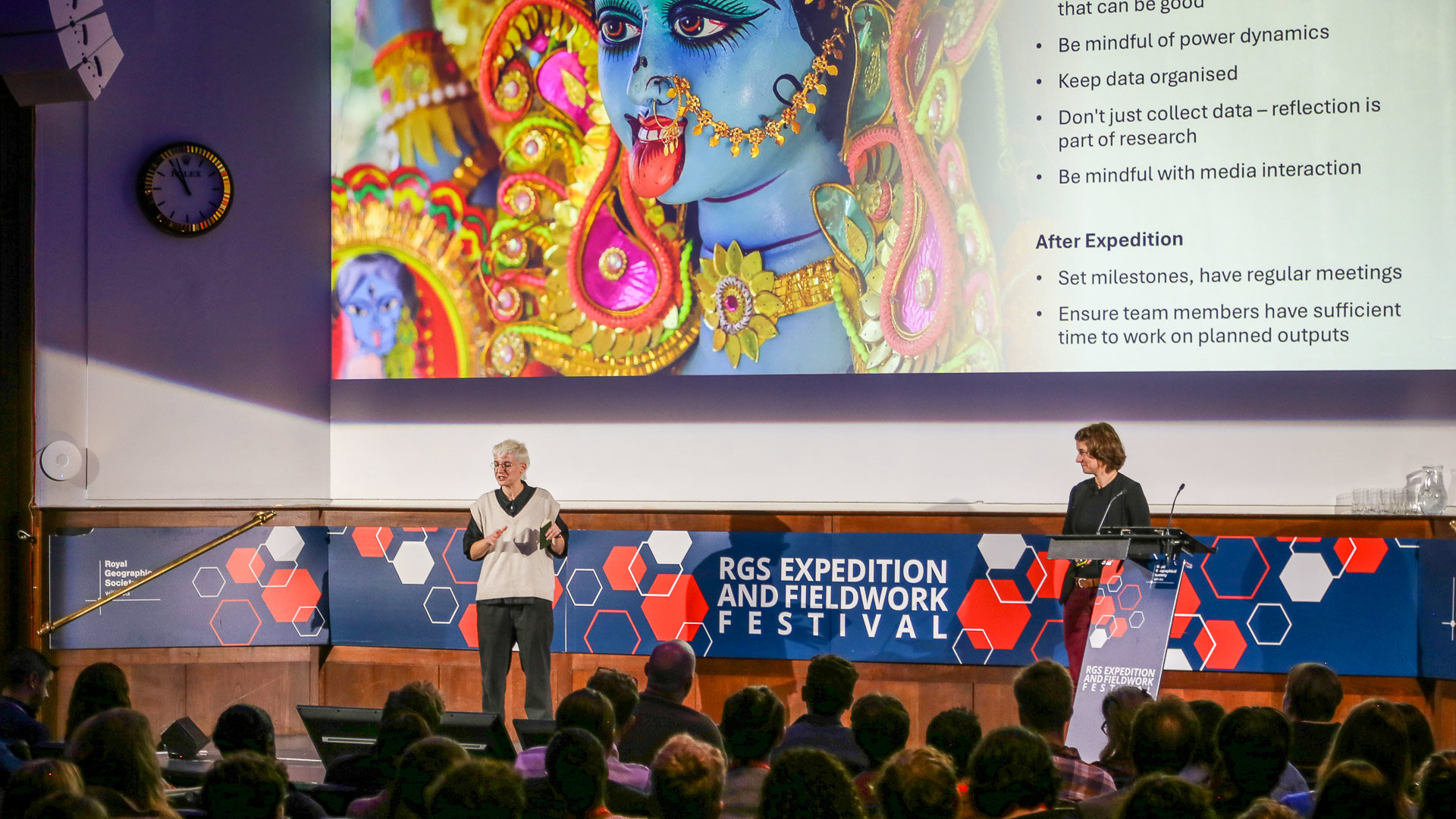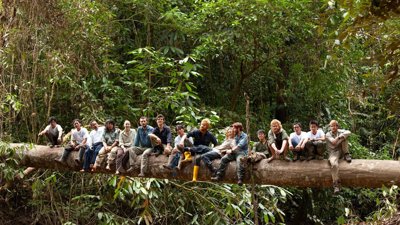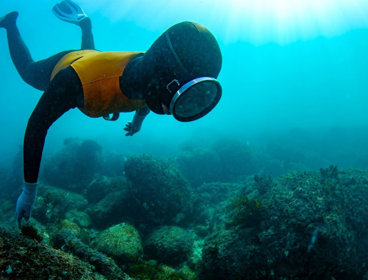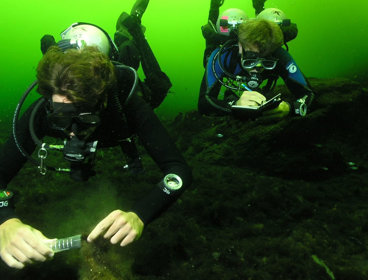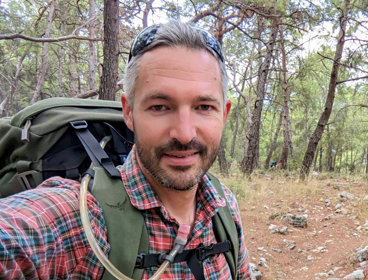The Royal Geographical Society has been at the forefront of exploration and expedition support for almost 200 years – and fundraising questions are some of the most frequent we receive.
Among the many tried-and-tested approaches to funding an expedition, crowdfunding is an immensely powerful tool, not just to raise money but also to shine the spotlight on the work that you’re doing. You can build a valuable support network and develop skills – not just in the field, but interpersonal skills, homing in on how to engage with an audience, and forming lasting relationships both personally and professionally.
This article is part of our library of expedition planning resources and offers specific advice on how you can start a crowdfunding campaign – raising funds from many people who contribute a relatively small amount each – to support your project.
Read on to discover a strategic framework for effective expedition crowdfunding with a focus on tailoring your approach to your expedition’s unique impact, activities and geographical location.
Identify your aligned tribe
When starting out on your crowdfunding journey, the first question to ask yourself is who will genuinely care about your project enough to invest in it based on its potential impact and real-world contribution.
There are several potential audience groups who could form the core of your crowdfunding foundation:
- Friends and family: The people closest to you in personal terms will be the group who will quickly get on board to support you. They will be invested in your passion and the ambition you have for your project as they know and care about you and your goals. They are also a group who is likely to share your crowdfunder with others around them, making them very valuable to spread the word of your project.
- The wider community: Your expedition’s overarching theme or discipline will attract this specific group.
- Niche communities: The geographical location of your project will draw the interest of this group of people. Additionally, the specific activities of it, for example: the study of a specific species of rare marine life, will take the attention of certain people, and how you are carrying out your work. Something specific will resonate with this group which will provide the motivation to donate.
Friends and family aside, what does your ideal supporter profile look like? Where do these communities who align with your project and its goals gather? Who are these people who care about marine life in the Indian Ocean, or archaeological surveys in Crete? You should be aiming to target that audience with material that will grab their attention. Do that and you will be well on the way to a successful crowdfunding campaign.
As Tom Allen, the Society’s Expeditions and Fieldwork Manager who has been part of multiple expeditions over the past decade, says: “because of the rise of social media and the internet, you can very easily find like-minded people who share your worldview and interested in what you're doing.”
Build an impactful narrative
When putting together a crowdfunding campaign, the emotional appeal of your story should resonate through your campaign material. This human-interest angle can help to build a connection between you and your potential funders.
“I think it’s okay to put personal motives first in crowdfunding, because that is ultimately the compelling story that people want to come to its natural conclusion, and that is why people will chip in with this small amount of money,” says Tom.
What motivated you to do this? What is the main aim of your expedition? You will want to present it as an inspiration to your audience and create a feeling of empathy. Speaking about the important discoveries and advancement of knowledge resulting from your project will provide excitement to your audience. Your expedition could have a lasting and meaningful impact and contribute to the betterment of our society, sustainability and future generations.
How might this affect the person viewing your crowdfunder? One main aim here is to make the audience feel empowered – the hero. By contributing, the donor is making a positive difference, to the advancement of science and to society. They’re doing a good thing by donating rather than giving money to an entirely self-centred cause.
Whilst you should present your goals as ambitious, they should also be attainable. If what you’re setting out to do doesn’t seem believable then you will struggle to gather donations. The contributions made by potential donors should also link directly to how you will achieve your goals. Your donation will allow the team to purchase the equipment needed to carry out its research? This is your contribution, and we thank you.
Another element to a successful expedition crowdfunder is visual storytelling. High quality images that aid the emotional appeal of your campaign is one way of capturing the imagination. If you have the resources to produce a short video that vividly portrays what you’re setting out to do, where you are going, how the immersive experience of the project will make a positive impact thanks to a donation, this can make a significant difference. You can use this opportunity to produce an inspirational narrative that captures the spirit of the expedition, the story behind it and talk about the impact the discoveries of the forthcoming expedition will have. You can tailor this narrative to the audience that you’ve already identified and ensure that it aligns with their values and expectations.
Deep engagement in relevant disciplines and locations
When potential donors are scrolling endlessly past news, content, and other fundraisers online, it takes effort to stay visible and relevant. That’s why continued engagement is so important. Often, your audience won’t immediately stop at your campaign page the first time they see it. It may take several passes before your fundraiser receives a click and that potential donor takes notice. So, how do you stay visible?
Targeted outreach
Actively engaging in publications that are relevant to your audience and expedition is one way to keep in sight. Attend conferences and events in the same vein to meet your potential audience in person as well as online communities, social media groups and societies. Your friends and family will see your posts on social media feeds, but your core audience will need this extra engagement to become aware of what you’re setting out to achieve. Once the word is out, there is potential for newly engaged audience members to share your fundraiser, creating more opportunities to reach your goal.
Personalised communication
You can reach out directly to specific communities who share your values and goals for your expedition. Doing this can help members of these communities feel valued and acknowledged. They then have the opportunity to learn about your expedition which shares their views and values.
“I think the depth of engagement you have with individual people is by far the most valuable thing you can have when you’re trying to crowdfund your projects because the person who really cares about your success is the person who is going to fund you,” says Tom. “Whether it’s £10 or £100, they will want to contribute in a small way to your big project.”
Transparent, regular outcome-oriented updates
Share the journey. You can post updates with progress towards your fundraising your goal, post milestones, and once you’re close to your goal you can ask for support from your audience to share your campaign to help you complete that final push – or perhaps even donate once more.
When you reach a specific goal in your journey you can talk about how, thanks to the support of donations, you can now afford to do a certain activity, purchase a certain piece of equipment, or make a certain aim viable. This will help the audience feel like they’re contributing directly to the advancement and impact of your expedition before it even goes ahead.
Subscription models
Some expeditions or people who make these projects part of their career may want to consider using subscription platforms such as Patreon or Substack to receive regular donations from supporters. For a small and regular – often monthly – fee, donors can provide support to expedition projects and the people running them over the longer term. “This is a relatively new but growing part of the crowdfunding picture,” says Tom, “which might be more appropriate depending on the duration of a project or the long-term outlook of the work that’s going to come out of it.”
In return, you will generally be expected to provide something for this audience. Often early access to content, personalised messages, or the opportunity to engage directly with expedition members in Q&A sessions are common ways of doing this. Usually, the amounts associated with these platforms are small, so a common way to sell them to potential subscribers is to talk about it “being the price of a coffee” or similar. With that, you can potentially garner a regular trickle of income to support present and future projects.
Platform, budget, realism, and outcome-based perks
You’ve decided to put together a crowdfunding campaign, so now you need to get things in motion.
With a crowdfunder, there are a number of online platforms available to build a campaign on such as Indigogo, Kickstarter, or GoFundMe. Each is slightly varied, and most will charge a small fee when you receive your funds. You’ll want to ensure whichever one you choose aligns with your type of project, your audience, and offers a donor perk or reward model that fits with your design.
Key practical steps
- Budget: Put together a realistic and well-thought-out budget plan before you launch. Potential donors will want to see what their support will go towards and having a solid budget adds legitimacy to your project, showing that you are serious about your goals and have thought it through. You’ll want to be detailed, outlining what each specific aspect is forecasted to cost.
- Compelling campaign page: Ensure that your campaign page is engaging, has the right emotional hooks to engage your audience and make them feel like this is a project they want to be involved in. Make sure that the outcome-based perks or rewards on offer for supporting your expedition are front and centre.
- Targeted promotion: With so many social media channels, websites, societies and other online communities in existence there are numerous opportunities available to promote your campaign. Use many of them and ensure that you promote to your audience your shared values and ambitious but realistic goals as well as making the reward or perk aspect of becoming a support a clear and prioritised aspect.
- Consistent communication: Post regular updates. This will keep your supporters engaged and remind people who are on the fence about donating – or are too busy to have properly tuned in to your project – that you’re there and are working towards something positive and impactful that they care about.
- Demonstrate deliverability: You’ve promised your supporters that they’ll receive something tangible as a reward for supporting you. As your campaign progresses, it will be prudent to update supporters on the forthcoming delivery of said rewards. It shows that you’re holding yourself accountable to follow through with the promises you’ve made and that you are confident that your project will reach its goal.
- Define funding purpose and outcome-based perks: Primarily, your supporters will be funding your expedition because they have an interest in the outcome of it. The perks that you can provide for your supporters are often directly related to those outcomes, so take the time to strategically design a perk or reward list that relates to those outcomes. You’ll want to ensure that what you come up with directly appeals to your target audience groups, making your task of convincing them to support you far easier.
Consider initial self-funding for credibility
Before you start on your crowdfunding journey, consider the option of self-funding your initial expedition stages, such as a training mission with your teammates closer to home or outcome-driven pilot projects to gather preliminary data. Doing this will provide you with credibility, which will be especially important if this is your first expedition. Benefits of this hybrid approach include:
- Freedom and flexibility: By being only accountable to yourself, you’ll have the ability to take the time to refine what questions you are trying to answer, hone your methods, and not be as restricted with time and deadlines.
- Learning through mistakes: When embarking on a new expedition, practices will take time to hone, methodologies will not be as efficient as they should be, and mistakes will be made. By surpassing this stage, your methodology will develop and ensure that when you do enter the field for the final expedition you will be far more practised and efficient.
- Credibility and portfolio building: Having been out into the field and produced a portfolio of preliminary findings, you can showcase your team's capabilities and the expedition's potential impact to your supporters, giving them the confidence in you producing meaningful results off the back of their donations.
In summary: top tips for expedition crowdfunding
- Clarity: Is the donation charitable or an investment? Are your supporters donating towards the expedition itself or what comes out of it?
- Why should anyone care? Define the story of the expedition and what impact it will have. Unlock the emotion potential of it through this, the project purpose and the impactful discoveries your team will make.
- Realistic budget: Ensure your financial planning is thorough, robust, has contingencies built in for when the unexpected happens, as well as including the financial impact of the perks you will offer supporters.
- Targeted tribe, not mass audience: The expedition's discipline, location, and intended impact will help you align with your people. Focus in on the demographics who will be interested in supporting the expedition and the outcomes of it for a bigger impact when fundraising.
- Believability and deliverability: Aim high but make those aims realistic. If your expedition activities and potential outcomes don’t seem attainable then you’re less likely to receive the funding you’re targeting. Similarly, ensure your perks or rewards are believable too and ensure you communicate regularly with your supporters as the delivery of them approaches.
- Outcome-centric approach: Your entire crowdfunding strategy can focus on the tangible outcomes and lasting impact of your expedition. How you will get there is important, but your impending achievements are key to unlocking the imagination of your audience.
Conclusion
Unlocking the emotional response of your audience is key to making them feel involved in what you’re working towards. Identify your tribe and you will find people who care deeply about the impact your work will have and the positive outcomes on the horizon. Using an impact-focused approach to your campaign will aid this, as well as thoughtful and emotive storytelling surrounding how your project came to be.
Outcome-driven pilot projects which are self-funded will be an effective way of building your own credibility and provide tangible proof points to show that what you want to achieve is ambitious but realistic.
Ultimately, crowdfunding is about inspiring your supporters. What you’re doing will help make the world a better place – and their support will be integral to making it happen.
Stay updated
Be the first to hear when new resources are launched by subscribing to our monthly exploration community newsletter. You'll also receive relevant news and events from the Society.
- You will be asked to create a free Society account if you haven't already done so.
- Once logged in, navigate to My preferences and select News and events about fieldwork and expeditions.
